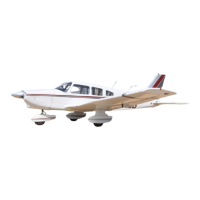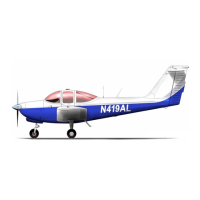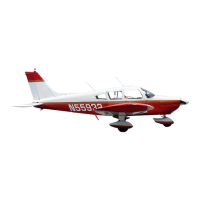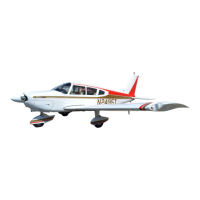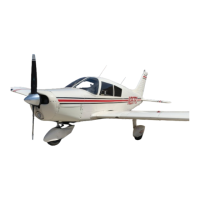THE NEW PIPER AIRCRAFT, INC.
PA-32-301FT / 301XTC
MAINTENANCE MANUAL
PAGE 2
Feb 19/04
4C8
39-10-00
(2) Installation
NO
TE: Inspect the front of the panel-mounted avionics tray/rack to verify it is not significantly
inset from the panel. If so, correct the tray/rack installation before proceeding.
NO
TE: The high insertion forces required to seat a unit with “high density” connectors tend to
limit the effectiveness of the first seating attempt. Accordingly, the following procedure
requires sequential applications of force, and subsequent tightening of the jackscrew,
to ensure all connectors seat properly.
(a) Slide the avionics unit into the instrument panel rack and forward applying a moderate
insertion force.
(b) Insert an appropriate size (generally 3/32 inch) allen wrench into the jackscrew access
hole in the faceplate and tighten to remove any slack, but do not try to “pull” unit into place
with the jackscrew.
(c) Apply additional insertion force to front of unit.
(d) Tighten jackscrew again.
(e) Apply additional insertion force to front of unit.
(f) Finish tightening jackscrew.
(g) Ensure that unit bezel is “tight” against panel.
2. Circuit Breaker Panel
Circuit breakers are installed in the lower right instrument panel and are of the single hole mounting,
pushbutton type, with manual reset.
Should a circuit breaker be replaced or added, exercise extreme caution ensuring the breakers are in
proper mechanical alignment, any insulators that are called out are installed correctly, and all electrical
wiring and connections meet aviation standards. Do not deviate from the parts manual requirements
when replacing circuit breakers.
3. Switches
All switches are rocker-type. Most are located in the overhead switch panel, but a few are centrally
located in the instrument panel.
CA
UTION: ALTHOUGH SMALL SWITCH ASSEMBLIES ARE EASIER TO REMOVE IF WIRING IS
FIRST DISCONNECTED, THE LIMITED WORK SPACE BEHIND THE PANEL CAN
RESULT IN BURNED WIRE INSULATION. DO NOT ATTEMPT TO UNSOLDER THESE
SMALL ELECTRICAL CONNECTIONS BEHIND THE INSTRUMENT PANEL UNDER ANY
CONDITIONS. IF NECESSARY, CUT WIRES AT POINT OF CONNECTION. IN ANY
CASE, IT’S BETTER TO DAMAGE THE SWITCH AND REPLACE IT, RATHER THAN
DAMAGE THE WIRING HARNESS LEADS.
A. Removal
(1) Gain access to the switch from behind the instrument panel.
(2) Squeeze retainer blades on top and bottom of the switch together and push switch from the
panel.
(3) Make note of the placement of, and/or tag, wires on the switch to facilitate installation.
(4) Disconnect wires from the switch. Remove switch.
B. Installation
(1) Connect wires to the switch.
(2) Squeeze retainer blades on top and bottom of the switch together and push switch into panel
until retainer blades engage the panel.
